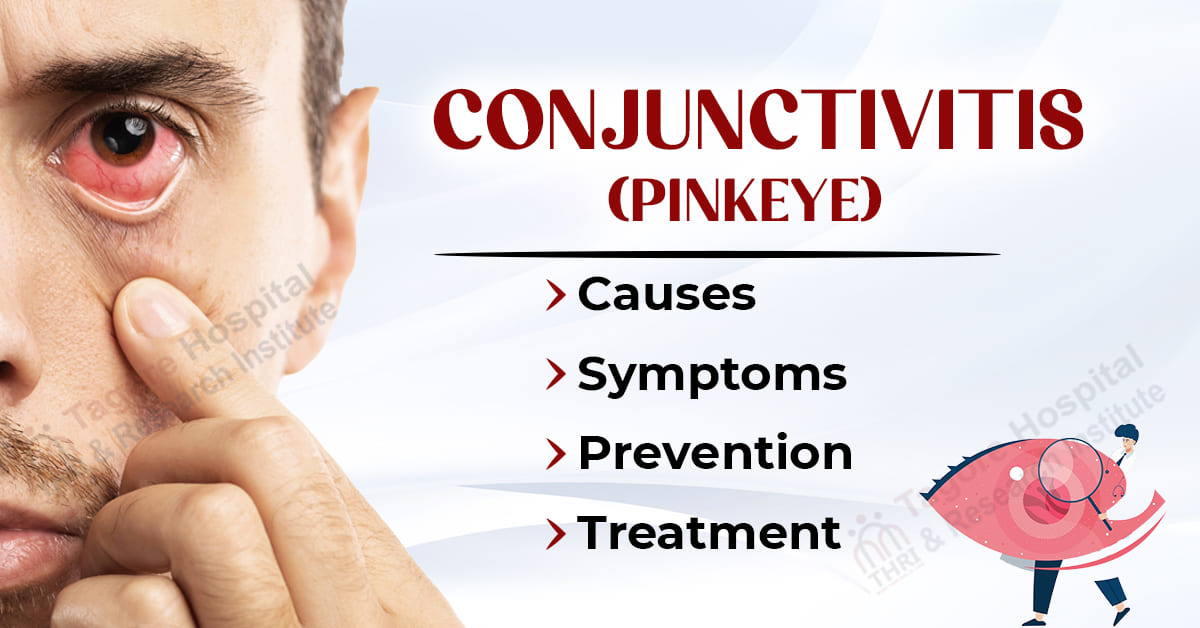- By Tagore Admin
- Posted September 14, 2023
What is Conjunctivitis (Pinkeye)?
A pink eye occurs when the transparent membrane lining the eyelid and eyeball becomes inflamed. This membrane is called the conjunctiva. When the conjunctiva is inflamed or swollen, small blood vessels can be seen more clearly. Due to this, the whites of the eyes appear pink or reddish. Pink eye is also known as conjunctivitis.
The most common cause of pink eye is viral infection. A bacterial infection, an allergic reaction, or a partially opened tear duct in an infant could also cause it.
Pink eye is rarely associated with vision impairment, despite its potential for irritation. The discomfort associated with a pink eye can be reduced with the help of treatments. The spread of pink eye can be limited by receiving an early diagnosis and taking specific precautions.
Types of Pinkeye
There are several types of conjunctivitis, and they can be categorized based on their causes or characteristics. Here are some of the main types of Conjunctivitis:
1. Infectious Conjunctivitis:
- Viral Conjunctivitis: This is often caused by viruses, such as adenovirus or the common cold virus. It is highly contagious and typically starts in one eye and can spread to the other.
- Bacterial Conjunctivitis: Bacteria like Staphylococcus or Streptococcus can cause bacterial conjunctivitis. It can result in a yellow or green discharge and may affect one or both eyes.
- Chlamydial Conjunctivitis: Chlamydia trachomatis can cause a type of conjunctivitis, which is usually associated with genital chlamydial infection and can affect newborns during delivery.
2. Allergic Conjunctivitis: This type of conjunctivitis is triggered by allergens, such as pollen, dust mites, pet dander, or particular eye drops. It typically affects both eyes and can be seasonal (e.g., hay fever) or perennial (year-round).
3. Giant Papillary Conjunctivitis (GPC): GPC is often linked to the use of contact lenses, exceedingly soft contact lenses. It causes the development of large, raised bumps (papillae) on the inner surface of the upper eyelids.
4. Chemical Conjunctivitis: Exposure to irritants or chemicals, like smoke, fumes, or chlorine in swimming pools, can cause chemical conjunctivitis.
5. Neonatal Conjunctivitis: This type affects newborns and can be caused by various factors, including infection (usually chlamydial or gonococcal), irritation from eye drops used at birth, or blocked tear ducts.
6. Non-Infectious Conjunctivitis: Certain systemic diseases, like rheumatoid arthritis or lupus, can lead to inflammation in the eyes, causing non-infectious conjunctivitis.
7. Irritant Conjunctivitis: This is often the result of physical irritation to the eye, such as foreign bodies or contact lens-related issues. It may not be an infection but can cause redness and discomfort.
8. Toxic Conjunctivitis: Exposure to harmful substances, like certain eye medications or environmental pollutants, can lead to conjunctival inflammation.
You Can Read Also:- Hair Loss: Causes, Symptoms, and Treatment & Prevention
Symptoms of Conjunctivitis (Pinkeye)
The symptoms of conjunctivitis (pinkeye) can include:
- Redness: The white part of the eye appears pink or red if you have conjunctivitis.
- Irritation: Eyes may feel itchy, burning, or gritty.
- Tearing: Excessive tearing or watery eyes.
- Discharge: A watery or thick, yellow, green, or white discharge may occur, depending on the type of conjunctivitis (viral, bacterial, allergic, etc.).
- Swelling: Swollen eyelids and a puffy appearance around the eyes.
- Light Sensitivity: Increased light sensitivity (photophobia).
- Blurry Vision: Vision may be temporarily blurred, especially if there is significant discharge or swelling.
Causes of Conjunctivitis (Pinkeye)
Conjunctivitis, commonly known as pinkeye, can have various causes, including:
- Viral Infections: Often caused by the same viruses responsible for the common cold, such as adenovirus.
- Bacterial Infections: Typically caused by bacteria like Streptococcus pneumoniae or Staphylococcus aureus.
- Allergies: Allergic reactions to pollen, dust, pet dander, or other allergens can lead to allergic conjunctivitis.
- Irritants: Exposure to irritants like smoke, chemicals, or foreign objects can result in irritant conjunctivitis.
- Contact Lenses: Improper use or hygiene of contact lenses may cause contact lens-related conjunctivitis.
- Sexually Transmitted Infections: Certain STIs, such as chlamydia or gonorrhea, can cause conjunctivitis when the eye is exposed to infected genital secretions.
- Newborns: Neonatal conjunctivitis can occur in newborns, often due to infections acquired during childbirth.
- Autoimmune Conditions: In rare cases, autoimmune diseases like rheumatoid arthritis or lupus can lead to conjunctivitis.
- Chemical Exposure: Exposure to certain chemicals, especially in industrial settings, can result in chemical conjunctivitis.
- Trauma: Physical injury to the eye can cause traumatic conjunctivitis.
You Can Read also: Infected Stitches
Diagnosis of Conjunctivitis (Pinkeye)
Diagnosing conjunctivitis, commonly known as pinkeye, typically involves a combination of a physical examination, medical history, and sometimes laboratory tests. Here's how it's typically diagnosed:
1. Medical History: The healthcare provider will ask about your symptoms, including the duration and severity of redness, itching, discharge, or any other eye-related issues. They may inquire about recent exposure to allergens, irritants, or infected individuals.
2. Physical Examination: The doctor will perform a thorough examination of your eyes. They will use a light source and magnification to inspect the conjunctiva (the thin, clear tissue covering the white part of the eye) for signs of redness, swelling, discharge, or other abnormalities.
3. Visual Inspection: The healthcare provider may visually inspect your eyes to look for specific characteristics that can help differentiate between the types of conjunctivitis. For example, viral conjunctivitis may cause watery discharge, while bacterial conjunctivitis can result in thick, pus-like discharge.
4. Laboratory Tests: In some cases, the doctor may order laboratory tests to confirm the diagnosis or determine the specific cause of conjunctivitis. These tests may include:
- Culture and Sensitivity: A swab of the eye discharge can be sent to a lab for culture to identify the bacteria or virus responsible and to determine which antibiotics or antiviral medications are most effective.
- Allergy Testing: If allergic conjunctivitis is suspected, allergy tests (such as skin prick tests or blood tests) may be conducted to identify the allergen triggering the reaction.
- Exclusion of Other Conditions: In some instances, additional tests, such as ruling out corneal abrasions, foreign bodies, or other eye conditions, may be necessary.
5. Assessment of Associated Symptoms: The healthcare provider may assess any other symptoms you're experiencing, as some eye conditions can mimic conjunctivitis. They will want to ensure they don't miss any underlying issues.
Treatment of Pinkeye
Treatment of pinkeye (conjunctivitis) typically involves:
- Hygiene: Wash your hands frequently with soap and water to maintain healthy hand hygiene.
- Artificial Tears: Use over-the-counter artificial tears to relieve eye dryness and discomfort.
- Warm Compresses: Apply warm compresses to your closed eyelids to ease irritation and crustiness.
- Antibiotics: If the infection is bacterial, your doctor may prescribe antibiotic eye drops or ointment.
- Antiviral Medication: For viral pinkeye (caused by a virus like herpes or adenovirus), antiviral medications may be prescribed.
- Allergy Medications: For allergic pinkeye, antihistamine eye drops or oral antihistamines can help reduce symptoms.
- Avoid Irritants: Avoid factors that exacerbate the condition, such as contact lenses or exposure to allergens or irritants.
- Isolation: If the cause is infectious, practice good hygiene to prevent spreading the infection to others.
- Follow-up: Follow your doctor's recommendations, and if symptoms worsen or persist, seek medical attention.
Prevention of Conjunctivitis
To prevent conjunctivitis (commonly known as pinkeye), you can take several measures to reduce your risk of infection. The prevention strategies for conjunctivitis depend on its type (bacterial, viral, or allergic). Here are some general guidelines:
- Hand Hygiene: Wash your hands thoroughly with soap and water frequently, especially after touching your eyes, nose, or face. One of the best ways to stop the transmission of infection is by washing your hands.
- Avoid Touching Your Face: Try to avoid touching your eyes, nose, and mouth, as this can introduce germs to your mucous membranes.
- Avoid Sharing Personal Items: Do not share towels, pillowcases, or eye makeup with others, as this can spread the infection.
- Contact Lens Hygiene: Be sure to practice good hygiene if you wear contacts. Use fresh solution every day, wash your hands before touching your lenses, and clean and store them according to your eye care professional's instructions.
- Vaccination: In some cases, vaccines can help prevent viral conjunctivitis. Discuss with your healthcare provider if you should get vaccinated against certain infections, like the adenovirus.
- Allergen Avoidance: If you have allergic conjunctivitis, identify and avoid allergens that trigger your symptoms. This may include pollen, dust, pet dander, or certain foods.
- Eye Protection: When swimming, wear swimming goggles to protect your eyes from chlorine and other irritants in pool water.
- Proper Eye Care: If you have a pre-existing eye condition, follow your eye doctor's recommendations for treatment and care to reduce the risk of complications.
Tags






